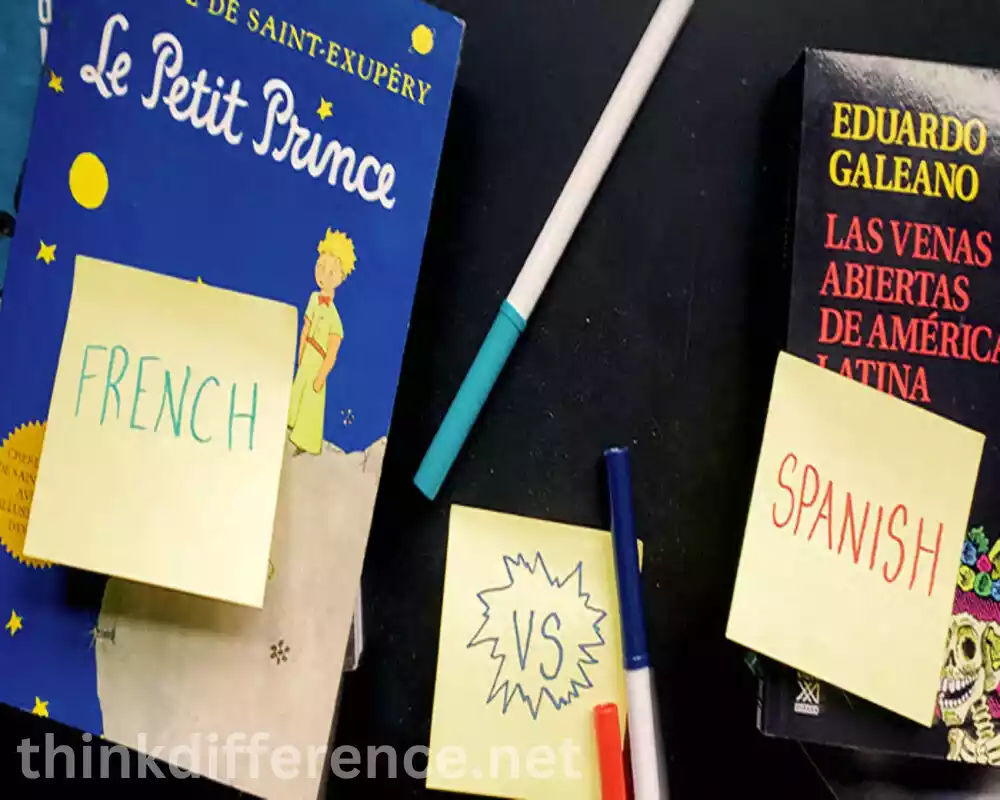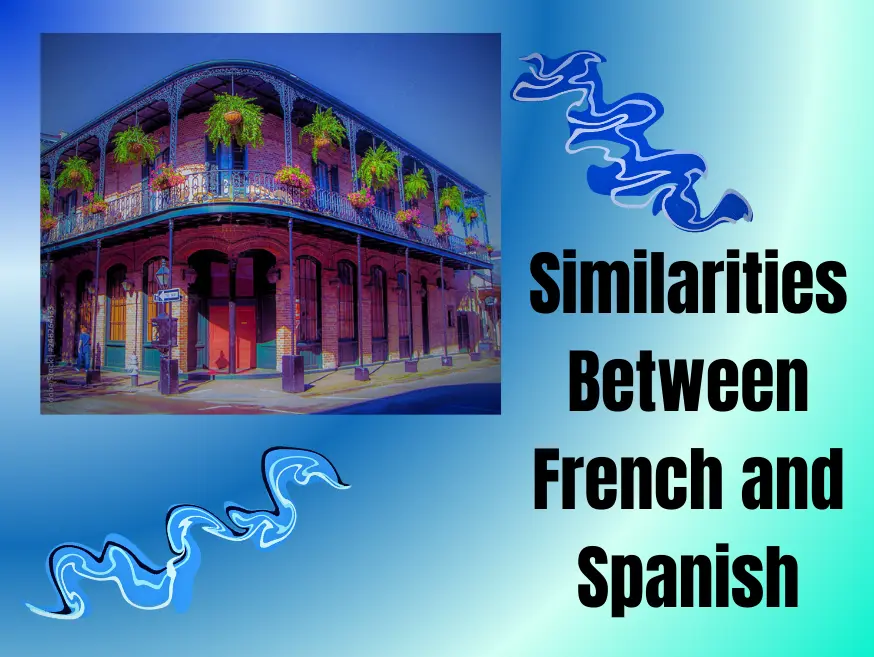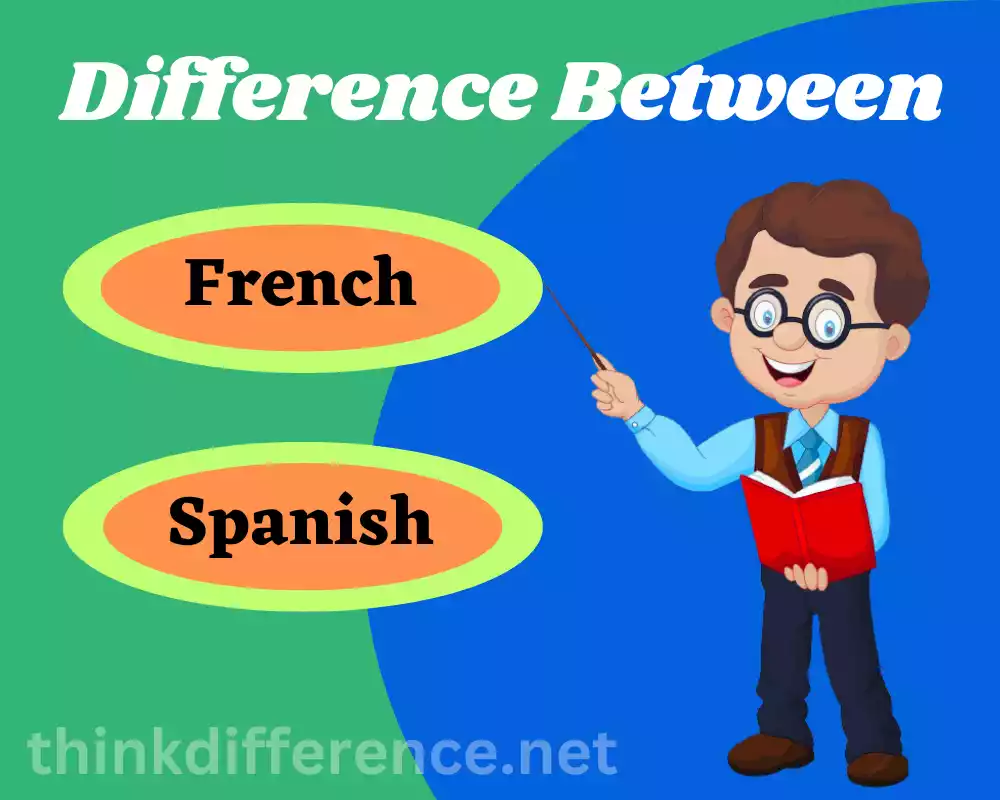French and Spanish are two widely spoken languages worldwide, both being popular among language enthusiasts and learners due to their historical and cultural importance. We will investigate similarities and differences between French and Spanish while looking at their origins and vocabulary – Join us on an intriguing voyage of French and Spanish worlds whether you want to learn another tongue or simply appreciate diversity within linguistics!
Explanation of French and Spanish
French and Spanish both belong to the Romance Language family, meaning they developed from Latin, an ancient language spoken during Roman Empire times. Each has unique features that distinguish it from its counterpart and they’re spoken all around the globe by people living different places.

French:
The French language (known by its French acronym of francais) hails from its homeland of France but today serves as an official language in a number of other countries around the globe, such as Canada (especially Quebec), Belgium and Switzerland as well as various African nations such as Morocco Tunisia Senegal where around 300 million individuals speak French either first- or second-language fluency.
Characteristics of French include:
- Phonetics: French has a unique phonetic system with nasalized vowels and distinct pronunciation features. Language features an intricate vowel system with nasal vowels and many consonant sounds.
- Grammar: French has a rich grammatical structure with verb conjugations, noun genders (masculine and feminine), and noun-adjective agreement. It uses subject-verb-object word order, but questions often use inversion or est-ce que.
- Vocabulary: French vocabulary has been influenced by Latin, Germanic languages (particularly Frankish), and English. It also has a considerable number of loanwords from other languages.
- Cultural Significance: France has long had an important global cultural influence, particularly on literature, philosophy, art and fashion. French culture can also be found in food such as croissants or snails from restaurants associated with French culture – as well as fashion houses like Chanel or Dior who make fashion statements through fashion design or their authors such as Victor Hugo or Albert Camus.
Spanish:
Spanish (known by various aliases such as “espanol”, “castellano” or simply as “Spanish”) is the second-most-spoken language worldwide after Mandarin Chinese and is officially used by Spain, Mexico and Colombia among many Latin American nations such as Argentina, Peru etc. Over 480 million people speak Spanish as their first language.
Characteristics of Spanish include:
- Phonetics: Spanish has a relatively consistent phonetic system with fewer vowel sounds compared to French. It maintains a clear distinction between voiced and voiceless consonants.
- Grammar: Spanish has a more straightforward grammar compared to French. It features verb conjugations, noun genders (though it is less prominent than in French), and noun-adjective agreement. It typically follows a subject-verb-object word order.
- Vocabulary: Spanish vocabulary has Latin roots but has been influenced by Arabic (particularly in Spain), indigenous languages of the Americas, and English. Spanish also uses diminutives and augmentatives more extensively.
- Cultural Significance: Spanish-speaking countries have rich cultural heritages, including influential literature from authors like Miguel de Cervantes and Gabriel Garcia Marquez, vibrant music styles like salsa and tango, and iconic artistic movements like surrealism. Spanish cuisine, such as paella and tacos, is globally recognized and enjoyed.
While both languages share similarities due to their common Latin origins, their distinct phonetics, grammar, vocabulary, and cultural influences make French and Spanish unique and fascinating languages to explore and learn.
Importance and popularity of French and Spanish worldwide
Importance and Popularity of French:
- International Language: French is one of six official UN languages and one of two working languages used by many international organizations such as the European Union and International Red Cross, where it acts as an informal lingua-franca.
- Global Reach: French is one of the world’s most spoken languages, spoken by over 300 Million people worldwide.
- Cultural Influence: French culture, including literature, art, fashion, cuisine, and cinema, has had a significant impact worldwide, contributing to the language’s popularity and desirability for cultural enrichment.
- Education and Academic Research: French is taught in schools and universities around the world, with many institutions offering French language programs and degrees. It is also a widely studied language in the field of literature, philosophy, and social sciences.
- Business and Trade: French is an integral business language in France, Canada, Belgium and Switzerland as well as parts of Africa where French is spoken natively, along with parts of Africa that use French for business communication purposes. French serves these nations’ strong economies and international trade relationships well while providing them with an essential tool to do business successfully.
Importance and Popularity of Spanish:
- Second Most Spoken Language: Spanish is the second-most spoken language globally after Mandarin Chinese. An estimated population of over 480,000,000 speak it as their first language.
- Global Presence: Spanish is spoken officially in 21 nations worldwide, including Spain, Mexico and Colombia as well as Argentina and several Latin American nations. Additionally there is also a large Spanish-speaking community within the US population.
- Cultural Heritage: Spanish-speaking nations possess an abundant culture, featuring literature, music and art that have garnered worldwide renown such as that of Miguel de Cervantes and Gabriel Garcia Marquez.
- Travel and Tourism: Every year, Spanish-speaking nations draw millions of tourists with their diverse landscapes, historic landmarks, vibrant cultures and rich histories. Knowledge of Spanish can greatly enhance travel experiences and facilitate communication.
- Economic Opportunities: Spanish-speaking countries have growing economies and expanding markets, providing numerous business and trade opportunities. Proficiency in Spanish can open doors for international business ventures and careers in various industries, including tourism, commerce, and finance.
The importance and popularity of French and Spanish can vary depending on factors such as geographical location, historical ties, and economic relations. This section highlights some of the key reasons why both languages hold significant global importance and enjoy widespread popularity.
Comparison table of French and Spanish
Here’s a comparison table highlighting some key aspects of French and Spanish:
| Aspect | French | Spanish |
|---|---|---|
| Origins | Derived from Latin | Derived from Latin |
| Speakers | Approx. 280 million worldwide | Approx. 460 million worldwide |
| Popularity | Widely spoken in Europe, Canada, Africa | Widely spoken in Spain, Latin America, and parts of the United States |
| Phonetic System | Complex phonetics, nasal sounds | Relatively phonetic, clear pronunciation |
| Verb Conjugation | Complex verb conjugation system with irregular verbs | Verb conjugation with regular and irregular verbs |
| Grammatical Gender | Nouns have grammatical gender (masculine or feminine) | Nouns have grammatical gender (masculine or feminine) |
| Vocabulary | Many shared words with English due to Latin influence | Some shared words with English, but fewer than French |
| Pronunciation | Vowel sounds can be challenging for non-native speakers | Pronunciation tends to be more straightforward |
| Cultural Significance | Known for its literature, fashion, cuisine, and arts | Rich cultural heritage with contributions to art, literature, music, and dance |
| Global Influence | Official language of numerous international organizations | Second most widely spoken language in the world after Mandarin Chinese |
| Dialects | Dialects vary across regions, such as Quebec French and Swiss French | Dialects vary across countries and regions, such as Mexican Spanish and Argentine Spanish |
Similarities Between French and Spanish

Despite their distinct characteristics, French and Spanish also share several similarities as Romance languages. Here are some key similarities between French and Spanish:
- Latin Roots: Both French and Spanish have Latin as their foundational influence due to their origins in the Roman Empire. Many words in both languages have Latin roots, although they may have undergone phonetic and spelling changes over time.
- Vocabulary Cognates: French and Spanish share many cognates; words with similar or identical meanings in either language that allow speakers of either to recognize and understand words from one language in another.
- Pronunciation of Certain Consonants: French and Spanish share similarities in the pronunciation of certain consonants. For example, the “b,” “d,” and “t” sounds are generally pronounced similarly in both languages.
- Verb Conjugation: Both French and Spanish have complex verb conjugation systems. Verbs are conjugated to match the subject in terms of person, number, and tense. Verb conjugation exists across languages despite any variations in specific conjugation patterns.
- Subject Pronouns: French and Spanish both use subject pronouns to indicate the subject of a sentence. While there are some differences in the specific pronouns used, both languages employ subject pronouns to convey information about the person or thing performing the action.
- Sentence Structure: French and Spanish generally follow a subject-verb-object (SVO) word order in declarative sentences. Subject and object typically go together. Both languages allow for some flexibility in word order, depending on emphasis or stylistic preferences.
- Romance Language Features: As Romance languages, French and Spanish share some broader linguistic features common to this language family. These include noun-adjective agreement, gendered nouns, and the presence of definite and indefinite articles.
Keep in mind that French & Spanish share many similarities. Learning their differences will assist those learning one language who wish to gain an understanding or basic knowledge of both.
Cultural Significance of French
The French culture holds significant influence and has made enduring contributions to various aspects of human civilization.
Here are some key elements of the cultural significance of French:
- Literature: French literature has a rich history and has produced numerous renowned authors and works that have shaped world literature. French literature, from classic writers like Victor Hugo and Moliere to contemporary authors like Albert Camus, Simone de Beauvoir and Albert Camus is celebrated for its depth, innovation and intellectual exploration.
- Art and Architecture: France is known for its extraordinary artistic heritage. French art movements like Impressionism and Cubism have left an indelible mark on world culture, inspiring iconic painters like Claude Monet and Auguste Renoir as well as architectural feats like Eiffel tower, Notre-Dame Cathedral and Versailles Palace; each stands as testaments of architectural brilliance as well as cultural importance.
- Fashion: France is internationally recognized as a fashion capital. Paris is famously associated with fashion houses Chanel, Dior and Louis Vuitton – three luxury fashion brands and fashion houses known for creating cutting-edge collections of clothing and fashion accessories. French fashion sets trends and inspires designers worldwide, making the country synonymous with elegance, sophistication, and style.
- Cuisine and Gastronomy: French cuisine is widely recognized and revered throughout the globe, famed for its exquisite culinary techniques and dishes such as croissants, coq au vin and escargots that have gained worldwide appreciation and admiration. The appreciation for food and the emphasis on quality and flavor are deeply ingrained in French culture.
- Philosophy and Intellectual Tradition: France has a long-standing tradition of intellectual pursuit and philosophical discourse. Rene Descartes and Jean-Paul Sartre are revered French philosophers renowned for their significant contributions to philosophy. Both continue to influence debates and theories today.
- Cinema: France has a prominent film industry and has produced numerous acclaimed filmmakers, actors, and films. The French New Wave movement in cinema was one of the most significant, impacting artistic expression, storytelling and narrative to create several cinematic movements in France. Cannes Film Festival remains one of the world’s premier festivals to this day.
- Cultural Heritage and Heritage Sites: France boasts a wealth of historical landmarks, UNESCO World Heritage sites, and museums that showcase its cultural heritage. From the medieval city of Carcassonne to the prehistoric cave paintings of Lascaux and the Louvre Museum in Paris, these sites preserve and showcase France’s rich history and cultural legacy.
The cultural significance of France extends beyond these aspects, permeating music, dance, theater, philosophy, and societal values. French culture is an international force; its aesthetic expressions, intellectual contributions and unique lifestyle have inspired and informed millions around the globe.
Cultural Significance of Spanish
Spanish culture holds significant cultural significance and has made notable contributions to various aspects of human civilization. Here are some key elements of the cultural significance of Spanish:
- Literature: Spain boasts an expansive literary tradition that ranges from medieval epic “El Cantar de Mio Cid” to Miguel de Cervantes’ Don Quixote and Gabriel Garcia Marquez’s One Hundred Years of Solitude (100 Years of Solitude). Spanish-language literature has produced Nobel laureates and has had a profound impact on world literature.
- Music and Dance: Spanish music and dance are globally recognized and celebrated. Flamenco, a passionate and expressive art form originating in Andalusia, is an integral part of Spanish cultural identity. Spanish classical guitar music, traditional folk music, and Latin American music genres such as salsa and tango have gained international popularity.
- Visual Arts: Spain has been home to influential artists throughout history. Spanish visual arts reflect Spain’s vibrant artistic legacy – from iconic artists such as Pablo Picasso and Salvador Dali to architectural marvels like Antoni Gaudi’s Sagrada Familia or Alhambra.
- Festivals and Traditions: Spain is renowned for its vibrant and lively festivals, which showcase the country’s rich cultural heritage. Events like La Tomatina, Running of the Bulls (San Fermín festival), and Semana Santa (Holy Week) attract visitors from around the world. These festivals exemplify the Spanish spirit of celebration, tradition, and communal gatherings.
- Cuisine: Spanish cuisine is esteemed worldwide for its diverse flavors and regional specialties. From paella and tapas to jamón ibérico and churros, Spanish culinary traditions emphasize fresh ingredients, traditional cooking techniques, and a strong sense of culinary heritage. Spain is widely acknowledged for its cuisine. Thanks to the chefs of Spain, international fame has been earned as a destination for culinary tourism.
- Language and Influence: Spanish is the second most spoken language globally, and its influence extends beyond linguistic boundaries. Spanish has spread worldwide through colonization, migration and other means. Its influence can be found throughout Latin America, Caribbean and parts of United States as evidenced by language and cultural characteristics present therein; Spanish-language films, music and literature continue to leave an imprint worldwide.
- Heritage Sites: Spain boasts several UNESCO World Heritage sites, such as Toledo and Alhambra in particular, plus the Santiago de Compostela pilgrimage route. These sites reflect Spain’s rich history, architectural wonders, and cultural legacy.
The cultural significance of Spanish extends to its literature, arts, traditions, and culinary heritage. Spanish-speaking countries have shaped and influenced the world through their artistic expressions, cultural celebrations, and contributions to various fields of knowledge and creativity. Spanish culture continues to charm and inspire millions worldwide.
French and Spanish in the Modern World
French and Spanish continue to hold significant relevance in the modern world, both as global languages and as cultural markers.
Here’s an overview of the roles and significance of French and Spanish in contemporary society:
French:
- International Diplomacy and Organizations: French remains an important language in international diplomacy. French is widely utilized by various international organizations, the European Union (EU), UNESCO, and International Olympic Committee.
- Education and Academia: French is taught as a foreign language in educational institutions around the world. There are countless universities offering French programs. Students looking for degrees in literature, philosophy and art often opt for them. French universities are recognized for their research and contribute to various academic disciplines.
- Cultural Influence: French culture, with its rich literary tradition, art, fashion, and gastronomy, continues to exert a strong influence globally. French literature, from classic authors like Victor Hugo to contemporary writers, holds a prominent place in the literary world. French fashion has long been associated with style and sophistication thanks to renowned labels like Chanel and Louis Vuitton.
- Tourism and Cultural Exchange: France is one of the premier travel destinations worldwide, welcoming millions of tourists each year. The French language plays a vital role in facilitating communication and enhancing the travel experience for visitors. French-speaking regions, such as Quebec in Canada, also draw tourists interested in experiencing Francophone culture.
Spanish:
- Global Population and Influence: Spanish is the second most widely spoken language worldwide, after Mandarin Chinese. It is the official language in 21 countries and is spoken by over 480 million people as their first language. The sheer number of Spanish speakers makes it a significant global language with broad influence.
- Economic Opportunities: Spanish-speaking countries, particularly those in Latin America, have growing economies and expanding markets. Proficiency in Spanish can be advantageous for business and trade opportunities, as it enables communication and understanding of these markets. Spanish is also important in the fields of tourism, hospitality, and customer service.
- Cultural Expression: Spanish-speaking countries have vibrant cultural expressions in various forms, including literature, music, dance, and cinema. Works by renowned authors Gabriel Garcia Marquez and Mario Vargas Llosa have garnered international acclaim. Latin American music genres like salsa, reggaeton, and tango have gained global popularity, contributing to the influence of Spanish-speaking cultures.
- Spanish in the United States: Spanish has long been recognized for its cultural relevance to America due to the large Spanish-speaking population here. Spanish ranks second as a language spoken across America and is frequently utilized for media consumption, entertainment purposes, business dealings and education purposes.
French and Spanish remain crucial languages in today’s globalized environment – from diplomacy and academia, business culture tourism. The global reach and cultural significance of these languages ensure their continued importance and impact in our interconnected world.
Tips for Learning French and Spanish
Learning French or Spanish efficiently can be rewarding and fulfilling experience. Below are some suggestions on how you can do just that efficiently:
- Set Clear Goals: Determine why you want to learn the language and set specific, achievable goals. Whether it’s for travel, career advancement, or personal enrichment, having clear objectives will motivate you throughout the learning process.
- Immerse Yourself: Immerse yourself as much as possible in French or Spanish by reading books, watching films and listening to music written performed in either language. Surrounding yourself with authentic language content will help you become familiar with pronunciation, vocabulary, and idiomatic expressions.
- Take Advantage of Online Resources: Numerous online resources are available to aid language learning. Use websites, mobile apps, and online language courses specifically designed for French and Spanish learners. These resources often provide interactive exercises, vocabulary lists, grammar explanations, and pronunciation guides.
- Practice Speaking and Listening: Language fluency comes from practice, so make speaking and listening practice a priority. Find language exchange partners, join conversation groups, or take part in language courses that emphasize conversation skills. Listening to podcasts or watching videos in the target language will also improve your comprehension skills.
- Use Flashcards and Vocabulary Builders: Build your vocabulary by using flashcards or digital vocabulary builders. Review words and phrases regularly to reinforce your memory. Practice using new vocabulary in context to make it more memorable.
- Focus on Grammar: While vocabulary is important, understanding grammar structures is crucial for language comprehension and effective communication. Allocate time to study grammar rules, verb conjugations, and sentence structure. Work through grammar exercises to reinforce your understanding.
- Practice Regularly: Consistency is key when learning a new language. Dedicate regular study sessions to French or Spanish, even if it’s just 15-30 minutes a day. Short, frequent practice sessions are more effective than sporadic, lengthy study sessions.
- Engage with Native Speakers: Interacting with native speakers is invaluable for improving your language skills. Seek opportunities to practice with native speakers, whether through language exchange programs, online forums, or language meetups. This will expose you to real-life conversational situations and help you develop your speaking and listening skills.
- Make Mistakes and Learn from Them: Do not fear making mistakes, making errors is part of learning and should not be seen as something negative. Embrace errors as opportunities to learn and improve. Native speakers appreciate the effort and will often help correct and guide you.
- Stay Motivated and Have Fun: Learning a language should be enjoyable. Find ways to make it fun and engaging, such as learning through music, watching movies, or playing language learning games. Celebrate your progress and milestones along the way to stay motivated.
Learning a language takes time and effort. Be patient with yourself, stay consistent, and celebrate your achievements as you progress in your journey to learn French and Spanish.
Common Challenges in Learning French and Spanish

Each new language comes with its own set of challenges for learners to conquer. Here are a few that typically arise when studying French or Spanish:
- Pronunciation: French and Spanish have distinct sounds that may be different from those found in your native language. Pronouncing words accurately, including the various vowel and consonant sounds, can be challenging at first. Paying attention to pronunciation guides, practicing with native speakers, and listening to audio resources can help improve your pronunciation.
- Verb Conjugation: Both French and Spanish have complex verb conjugation systems. Verbs have different endings and irregular forms, making it necessary to learn and practice conjugations thoroughly. Understanding verb tenses and their usage can be particularly challenging, but consistent practice and exposure to the language will help you become more comfortable with them.
- Grammar Structures: French and Spanish grammar have specific rules and structures that may differ from those in your native language. Understanding word order, noun-adjective agreement, pronoun usage, and grammatical exceptions can be difficult. It requires focused study and practice to internalize these rules and use them correctly.
- False Friends: French and Spanish share some vocabulary with English, but there are also many false friends, which are words that look or sound similar but have different meanings. Being aware of false friends and taking the time to learn the correct meanings of words will help avoid confusion and miscommunication.
- Listening Comprehension: Understanding spoken French and Spanish at a natural pace can be challenging, especially in the early stages of learning. Native speakers may speak quickly and use colloquial expressions or regional accents. Regular exposure to authentic audio resources, such as movies, podcasts, and conversations with native speakers, will improve your listening comprehension skills over time.
- Cultural Context: Language and culture are closely intertwined, and understanding cultural nuances can enhance language learning. French and Spanish have unique cultural contexts, idioms, and social customs that may be different from your own. Becoming familiar with the culture, traditions and etiquette associated with these languages can give greater depth of appreciation for them.
- Confidence and Speaking Practice: Building confidence to speak in French or Spanish can be a challenge, especially in the early stages. Fear of making mistakes or being misunderstood can hinder progress. Engaging in conversation with native speakers, language exchange partners, or taking part in language courses that emphasize speaking practice can help overcome this challenge.
These difficulties aren’t unusual and can be overcome with diligence, practice and dedication. Stay motivated, seek support from language communities, and embrace the learning process as you progress in your journey to master French and Spanish.
Resources for Learning French and Spanish
These resources offer great assistance when learning French or Spanish, including some of the more widely-used ones.
1. Online Language Learning Platforms:
- Duolingo: A popular language-learning app that offers gamified lessons for French and Spanish.
- Babbel: Provides interactive courses and exercises for beginners and intermediate learners in French and Spanish.
- Rosetta Stone: Offers comprehensive language courses with a focus on immersive learning.
- FluentU: Provides authentic videos with interactive subtitles to learn French and Spanish in context.
2. Language Learning Websites:
- BBC Languages: Offers free online courses, resources, and interactive exercises for French and Spanish learners.
- Lingoda: Provides online language classes with qualified teachers for personalized learning.
- WordReference: An online dictionary and language forum that offers translations, definitions, and language resources.
- Conjuguemos: Helps practice verb conjugation in French and Spanish with interactive exercises.
3. Mobile Apps:
- Memrise: Offers language courses, vocabulary memorization tools, and interactive quizzes for French and Spanish.
- HelloTalk: Connects language learners with native speakers for language exchange and conversation practice.
- Tandem: Another language exchange app that connects learners with native speakers for conversation practice.
- Anki: A flashcard app that uses spaced repetition to help you memorize vocabulary and grammar.
4. Podcasts and YouTube Channels:
- Coffee Break French/Spanish: Podcasts that teach French and Spanish with lessons for different proficiency levels.
- News in Slow French/Spanish: Podcasts that deliver news and current affairs at a slower pace to aid comprehension.
- Easy Spanish/French: YouTube channels that provide language lessons, interviews, and street conversations in a simple and engaging format.
5. Books and Textbooks:
- “Easy French Step-by-Step” by Myrna Bell Rochester
- “Practice Makes Perfect: Complete French Grammar” by Annie Heminway
- “Spanish Demystified” by Jenny Petrow
- “Practice Makes Perfect: Complete Spanish Grammar” by Gilda Nissenberg
6. Language Immersion and Cultural Resources:
- Watching French and Spanish movies with subtitles, such as those by renowned directors like Pedro Almodóvar (Spanish) and Jean-Pierre Jeunet (French).
- Reading books and literature in French and Spanish, starting with simpler texts and gradually moving to more complex works.
- Listening to French and Spanish music and podcasts to improve listening comprehension and exposure to the language.
- Traveling to French and Spanish-speaking countries to immerse yourself in the culture and practice the language with native speakers.
Remember to choose resources that align with your learning style and goals. Combining multiple resources, such as apps, textbooks, and immersion activities, can provide a well-rounded learning experience. Practice regularly and be consistent in your efforts, and you’ll make progress in your journey to learn French and Spanish.
Conclusion
French and Spanish, two extraordinary Romance languages, have played significant roles in shaping world history, culture, and communication. From their ancient origins to their modern-day influence, these languages continue to captivate the hearts of millions. Learning French and Spanish not only connects individuals across borders but also opens pathways to embracing diversity and fostering meaningful connections with people from all walks of life.



